Overview
To acquire specialized knowledge and advanced technology related to life science, food science, and environmental science from a comprehensive viewpoint of biological production. Therefore, We provide under the sharing and collaboration of the fields to which the course belongs, by comprehensively combining lectures, exercises, and experiments, a wide range of education from basics to applications related to life phenomena, bio-produced substances, environmental conservation and restoration, food, health, etc.
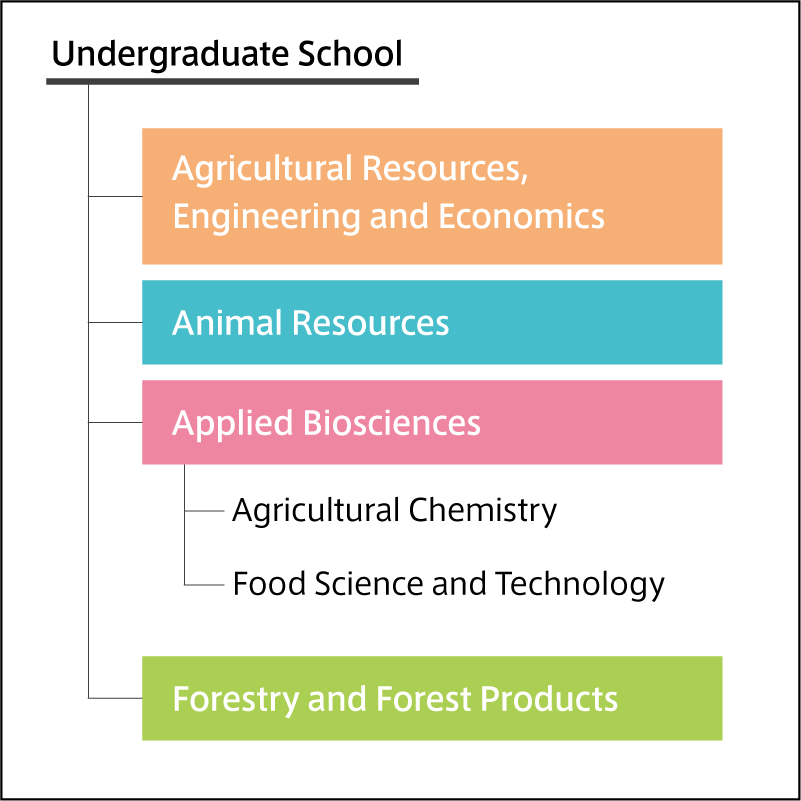
Agricultural Chemistry
Cutting-edge Biotechnology
Education and research in Agricultural Chemistry focuses on the functions of organisms and the use of substances produced by living organisms, grounded on chemistry and biology. This specialization deals with basic and practical issues across a wide range of fields from cutting-edge biotechnology to environmental science.
LABORATORY
Plant Nutrition, Soil and Environmental Microbiology, Applied Microbiology, Biophysical Chemistry, Molecular Gene Technology, Biochemistry, Pesticide Chemistry, Synthetic Biology, Bio-Process Design

-
More
Determining the 3D Structure of Enzymes and Unlocking the Mysteries of Living Phenomena
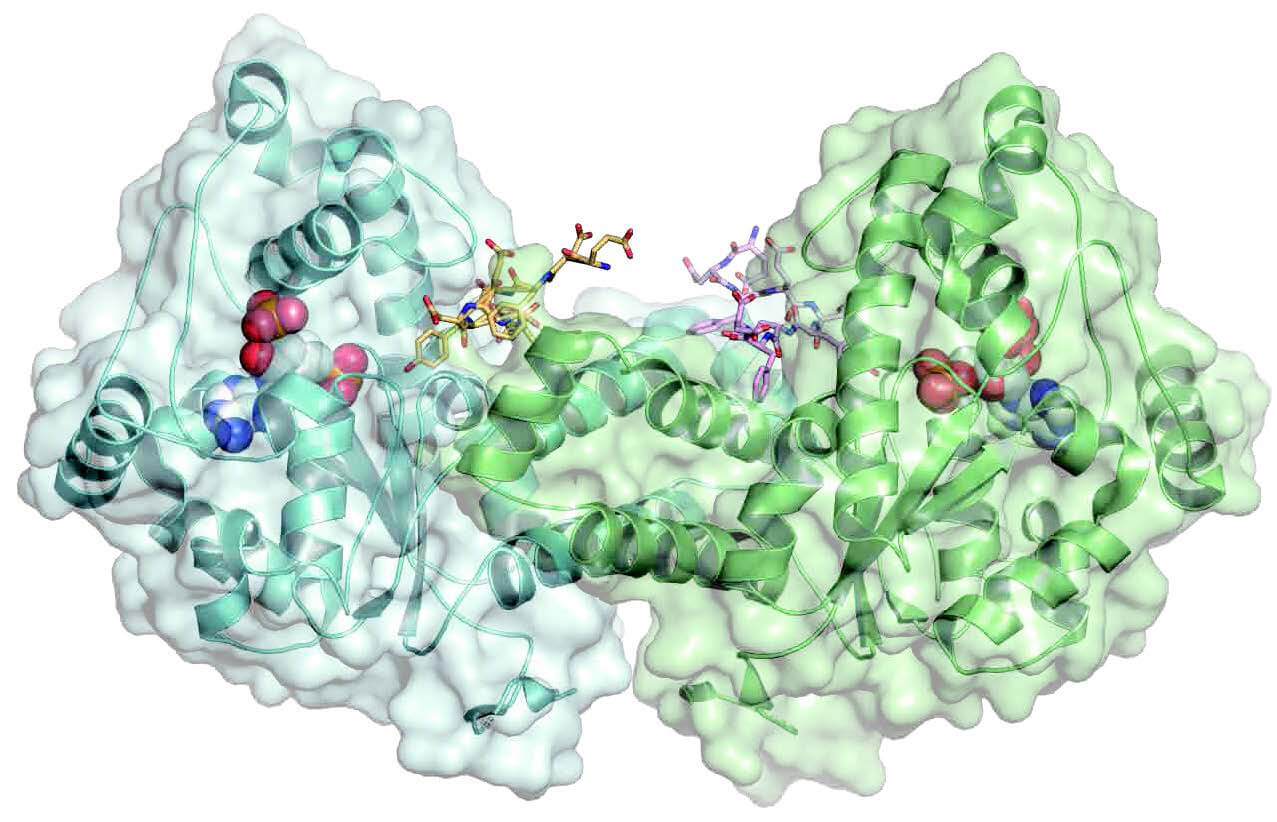
3D structure of enzyme working in humans determined by X-ray crystallography. Structural information on the atomic level reveals the relationship between keys (substrate) and keyholes (enzymes).
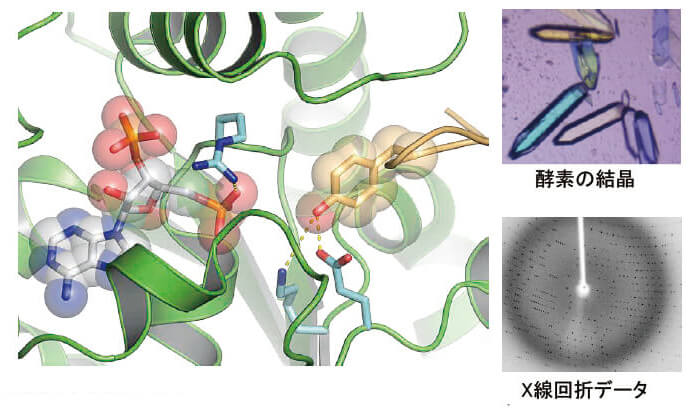
Close-up of the above active site.
Understanding the detailed reaction mechanisms expands the possibilities for application.Living factory producing biofuel from biomass was constructed in Escherichia coli
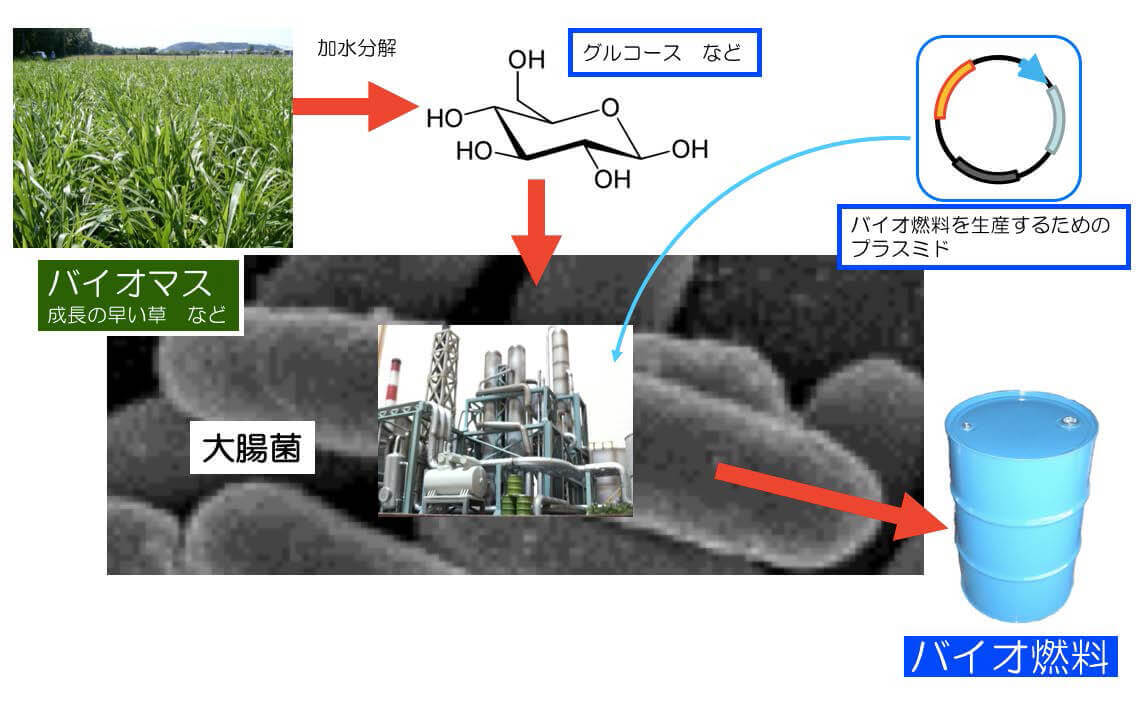
Genetically engineered E. coli produce biofuel (bioalcohol)
Evolutionary Lineage of Life on Earth and the Three-Domain System
The origin of life is still unknown, but living organisms on Earth today have been evolved from a common ancestor and are divided into three domains: Archaea, Bacteria, and Eukarya. Archaea and Bacteria are prokaryotes and have an acquired immunity system called CRISPR-Cas, which has become famous for its application to genome editing. On the other hand, by comparing the molecular machinery that replicates genome DNA, we can deduce that Archaea and Eukarya evolved from a common ancestor. In other words, archaeal organisms in prokaryote have replication machinery that is very similar to our machinery in human cells. The bacterial machinery have evolved from a completely different process, although both bacterial and archaeal organisms are prokaryotes, In Agricultural Chemistry, we are conducting research on molecular mechanisms that maintain the genome stability using hyperthermophilic archaea that can live in temperatures of 100˚C and above. Shedding light on the molecular mechanisms used to protect their own genetic information in extremely hot environments where life is easily damaged will lead to the development of novel technologies useful for genetic engineering.
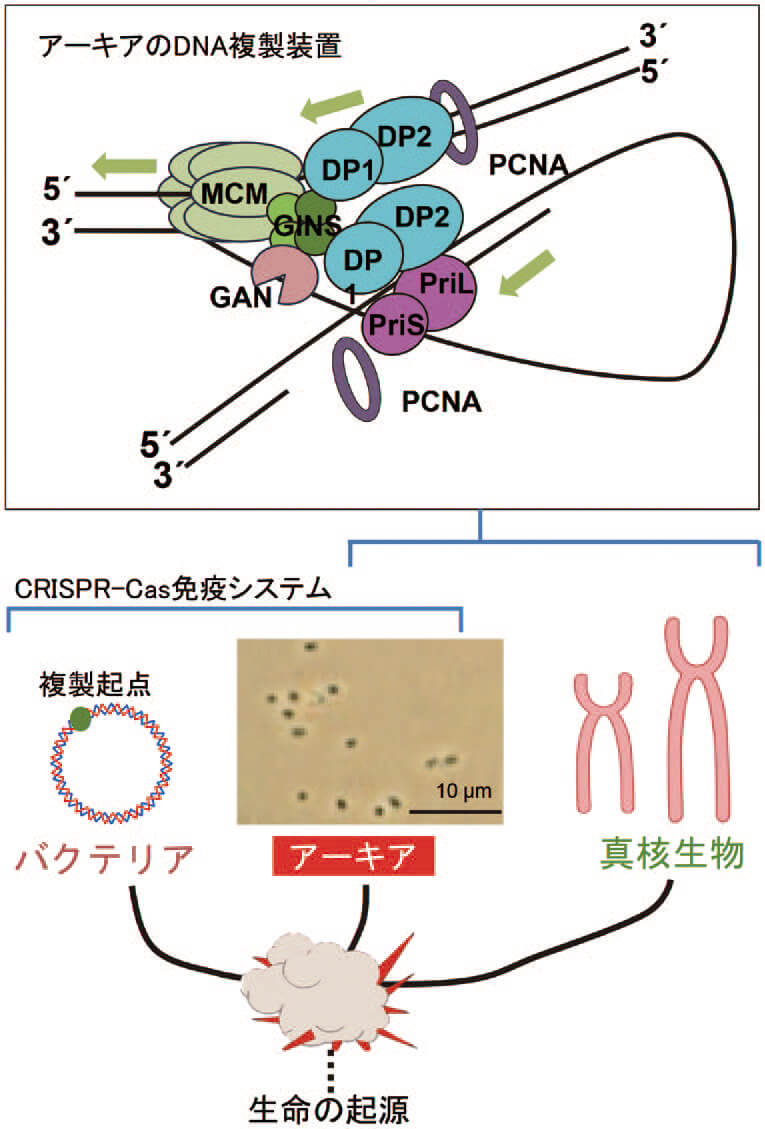
Molecular Biological Analysis of Complex Microbiome, and its Application on Sustainable Production System and Environmental Conservation
Most of the microorganisms in open treatment system of organic waste and waste water, as well as those in nature, have not yet been isolated and thus still lacking their names. We are investigating the community structures and assembled genetic information, to control the mixed culture systems, which would contribute to the recycling of biomass resources and establishing the sustainable society.
We are going to characterize the nobel microorganisms in situ that are difficult to isolate with traditional ways by applying new techniques for meta-genome analysis, fluoro- micromanipulater, and the systematic feed-back isolation, etc.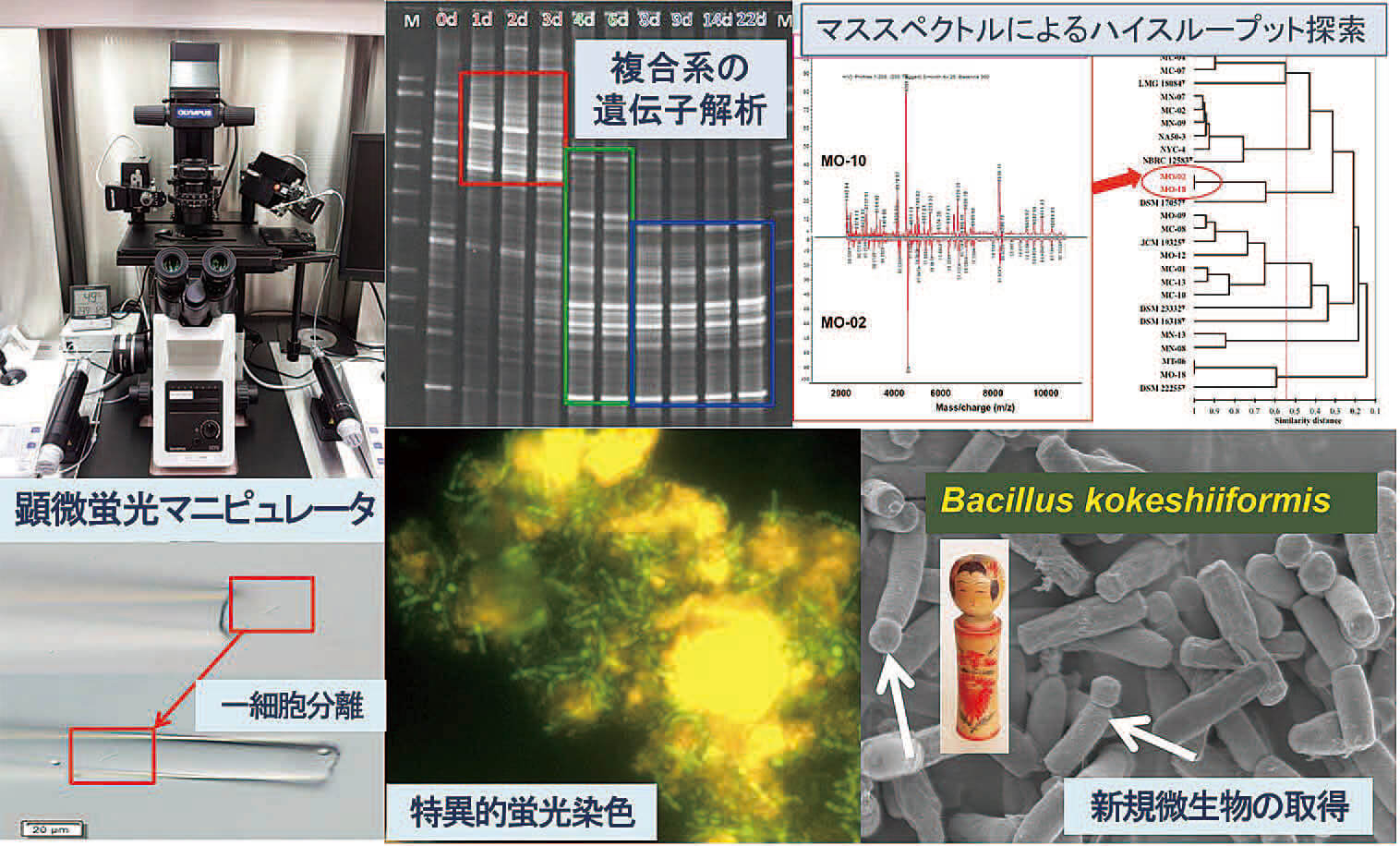
Message from the Director
In Agricultural Chemistry, we strive to understand the wide range of substances produced by the many chemical reactions that occur in the processes of life, and carry out bold research activities to apply this understanding to contribute to human progress, using basic molecular biology as the foundation to understand living phenomena from the perspective of chemistry. Through research, students will gain basic knowledge, acquire applicable skills, and develop outstanding insight.
Agricultural Chemistry comprises nine laboratories, which engage in cutting-edge biochemistry research using living organisms and biological communities as models. Students will gain an understanding of the structures and functions of substances including proteins, nucleic acid, carbohydrates, and low-molecular mass organic compounds involved in biochemical reactions such as the transmission of genetic information, intracellular transport, and the synthesis and conversion of intracellular substances, and conduct basic research to understand the molecular structure of new living phenomena and applied research that makes use of the results.
Reading biochemistry and molecular biology textbooks at university may give you the impression that there is nothing new to research. But when you actually start conducting experiments in the lab, you realize there is a lot we don’t know. You also learn just how fragile life is—changing just one nucleic acid sequence in the genome leads to death. Join us to apply the knowledge gained from unlocking the mysteries of living phenomena to contribute to the advancement of society.Prof. Kaoru Takegawa, Program Director, Agricultural Chemistry

Food Science and Technology
At the Forefront of Food Science and Technology
This research area carries the banner for bioscience based on life science and its technologies. Therefore, the kind of study we shall engage in is not just a parallel of biology, chemistry, and engineering, but rather a truly interdisciplinary domain that unifies these four subjects. Our research and education involve: (1) the advanced utilization of the functions of food materials and their by-products, the conversion of unused resources into food, and the development of new bioresources; (2) confirming the safety, quality and nutritional status of secondary and tertiary products of food; (3) clarifying the physical, chemical, and biochemical changes that occur in the production processes and their controls; and (4) the principles of food processing, related machinery, and the biological treatment of organic waste products.
LABORATORY
Nutrition Chemistry, Food Chemical Biology, Food Analysis, Food Hygienic Chemistry, Food Process Engineering, Microbial Technology, Cellular Regulation Technology, Microbial Bioresources, Functional Genomics and Metabolism
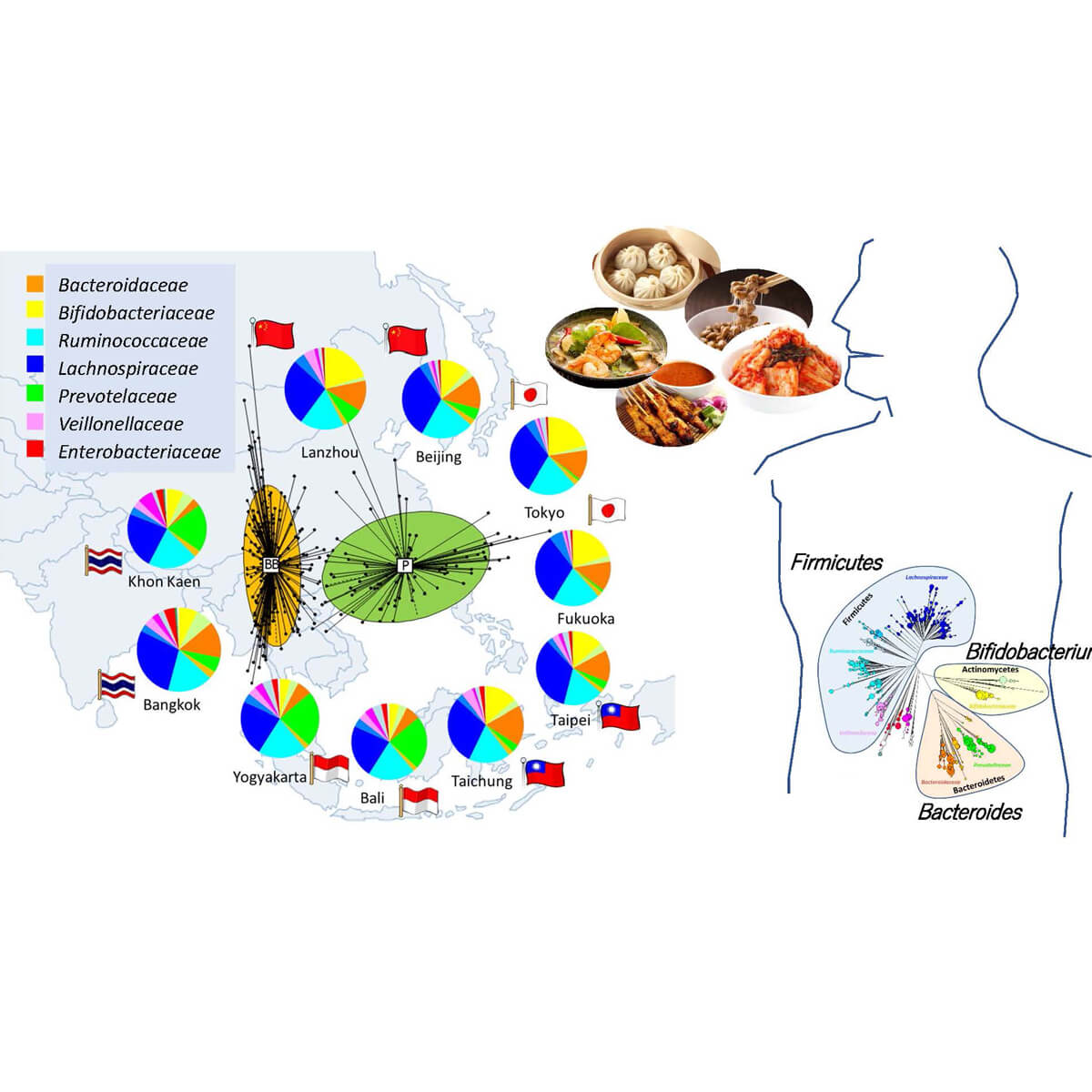
-
More
Prolonging the Brain’s Healthy Lifespan with New Nutritional Functions of Protein, Peptides, and Amino Acids
Protein, one of the three macronutrients, is composed of amino acids. In other words, amino acids are essential to the maintenance of our biological functions and structures. Amino acids are broadly divided into two types: essential amino acids, which our bodies cannot synthesize the required amount of, and nonessential, which our bodies synthesize and supply. If we do not get essential amino acids from protein and peptides found in food, we cannot maintain the growth and functions of our bodies. Our laboratories conduct research using a variety of methods to answer the following unsolved questions, with a focus on the nutritional and physiological functions of protein, peptides, and amino acids in the central nervous system.
1) Why do nonessential amino acids, which can be obtained from food, need to be synthesized in our bodies?
We are conducting research on central nervous system disease pathogenesis, using serine synthesis enzyme knockout mice created with cutting-edge genetic modification technology as a model for human hereditary nonessential amino acid serine synthesis deficiency. We also conduct molecular and cellular biological research on the pathophysiological significance of serine synthesis in cerebral degeneration diseases, and on the molecular mechanisms of serine deficiency response.
2) What effect does protein and amino acid malnutrition during development have on the nervous system in adulthood?
Recent research has revealed that malnutrition during the fetal and neonatal periods increase the risk of disease onset in adulthood. We focus on the link between protein and amino acid malnutrition during development and the risk of mental disorders in adulthood.
3) Neuro functional regulation based on food protein and peptides:
Still little is understood about the effects of protein and peptides contained in food on the brain. We have identified the actions in which peptides containing tyrosine in food protein encourage the function of catecholamine neurotransmitters in the brain and improve cognitive/memory impairment with amyloid peptides (see figure), and are researching their molecular mechanisms.
Our laboratories carry out such research and development work in partnership with industry, with the aim of using the diverse nutritional functions and biological regulation activities of protein, peptides, and amino acids to contribute to prolonging the healthy lifespan of the brain.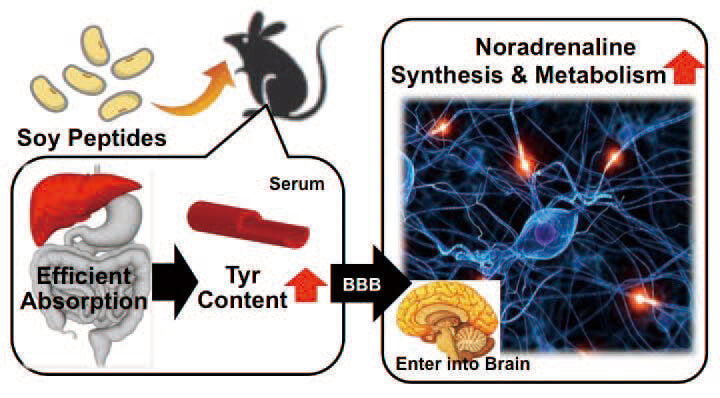
Did You Know that Spinning Produces Many Uniform Droplets?
What exactly are foods like mayonnaise and butter? Are they liquid? Solid? Actually, they are stable mixtures of ingredients that would normally separate like oil and water but maintain a stable form when broken up into tiny droplets and dispersed. This process is called emulsification. Many products around you are made with this process. An important part of the emulsification process is making the droplets uniform in size (monodispersed) and in a large quantity, and our laboratories have developed a high-speed rotational flow membrane emulsification method to efficiently create monodispersed droplets. As you can see in figure below, this method creates smaller monodispersed droplets than the conventional method. We also engage in many other research projects related to emulsions and aroma.
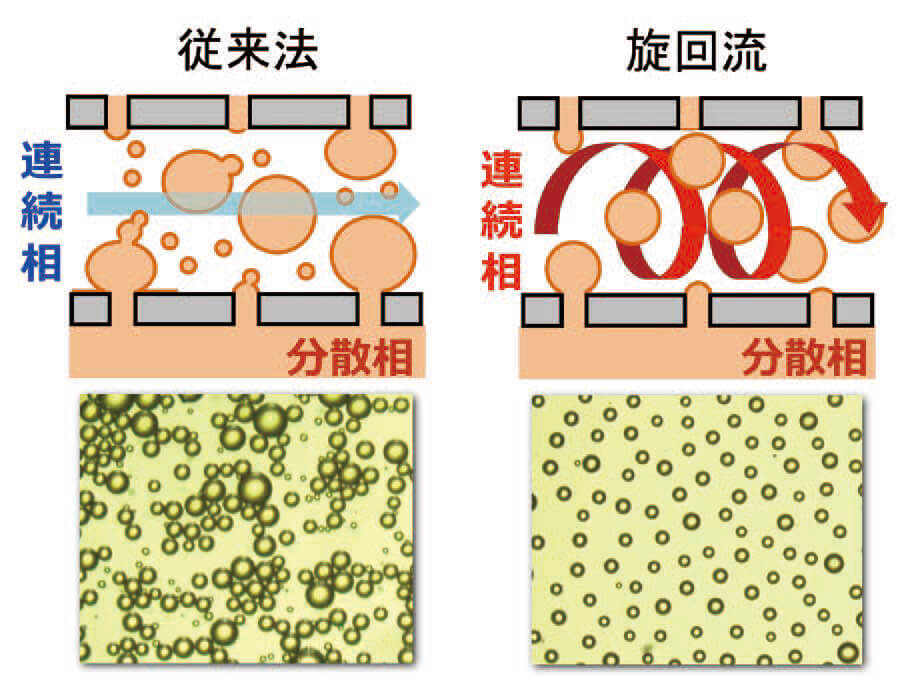
Comparison of the conventional emulsification method with high-speed rotational flow emulsification. The conventional method creates droplets of various sizes, while the rotational flow method makes droplets of mostly uniform size.
Study on “Gut Flora”—the Interface Between Food and Health
A total of 100 trillion bacteria of hundreds of different species are said to live in our gastrointestinal tract, forming a flora. They proliferate by consuming the food we ingest daily, but recent research has found that their metabolites and bacterial makeup have a huge impact on our health. Our laboratories conduct joint research with research groups across Asia, this university’s School of Medicine, and others regarding how the food we eat affects gut flora and how that is related to our health and to disease.
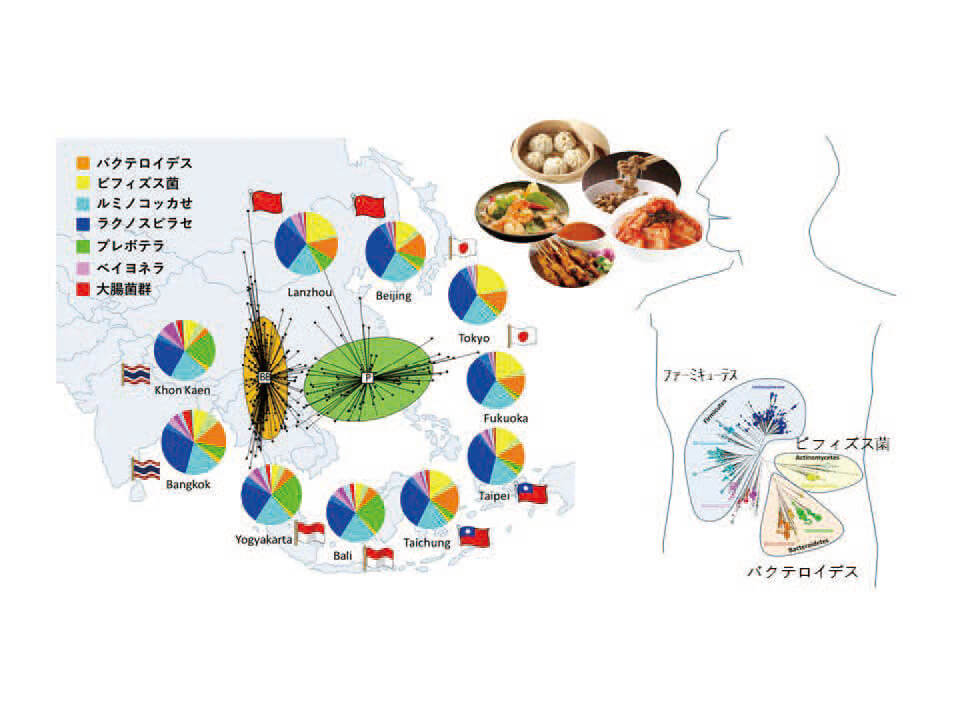
Message from the Director
Food is essential for our survival and to maintain life. However, food is more than just something we need to live. It plays a crucial role in lifestyle and culture, and there are a wide range of food cultures in countries and regions around the world. In this way, food provides humanity the joy of living and the mystery to maintain life. The objective of the Food Science and Technology program is to use cutting-edge food science and advanced biotechnology to conduct research, and foster people that will contribute to the maintenance of life and wellbeing of humanity. Comprising nine laboratories whose mission is to solve problems involving health, safety, quality, energy, and the environment, this specialization conducts research and provides education that leads food science not only in Japan but the world. We have achieved many outstanding interdisciplinary research outcomes in collaboration with other fields such as medicine, pharmacology, and engineering, and also produced many talented graduates who have gone on to successful careers. We are looking for enthusiastic young people who will drive the future of food science.
Prof. Toshiro Matsui, Program Director, Food Science and Technology

Let's Watch!
We have a video that introduces each field and lab to the public.
They have English subtitles, so be sure to check them out!